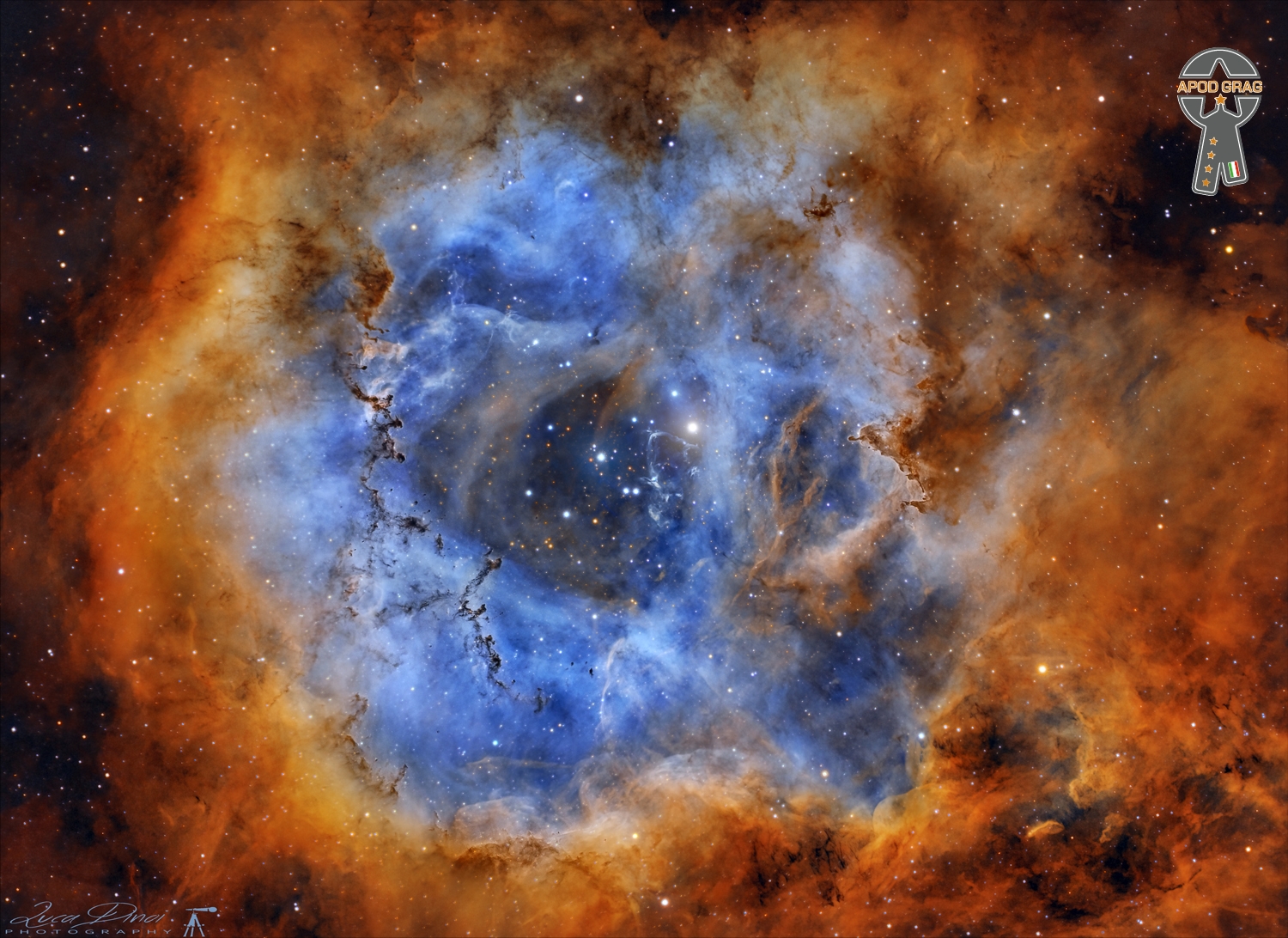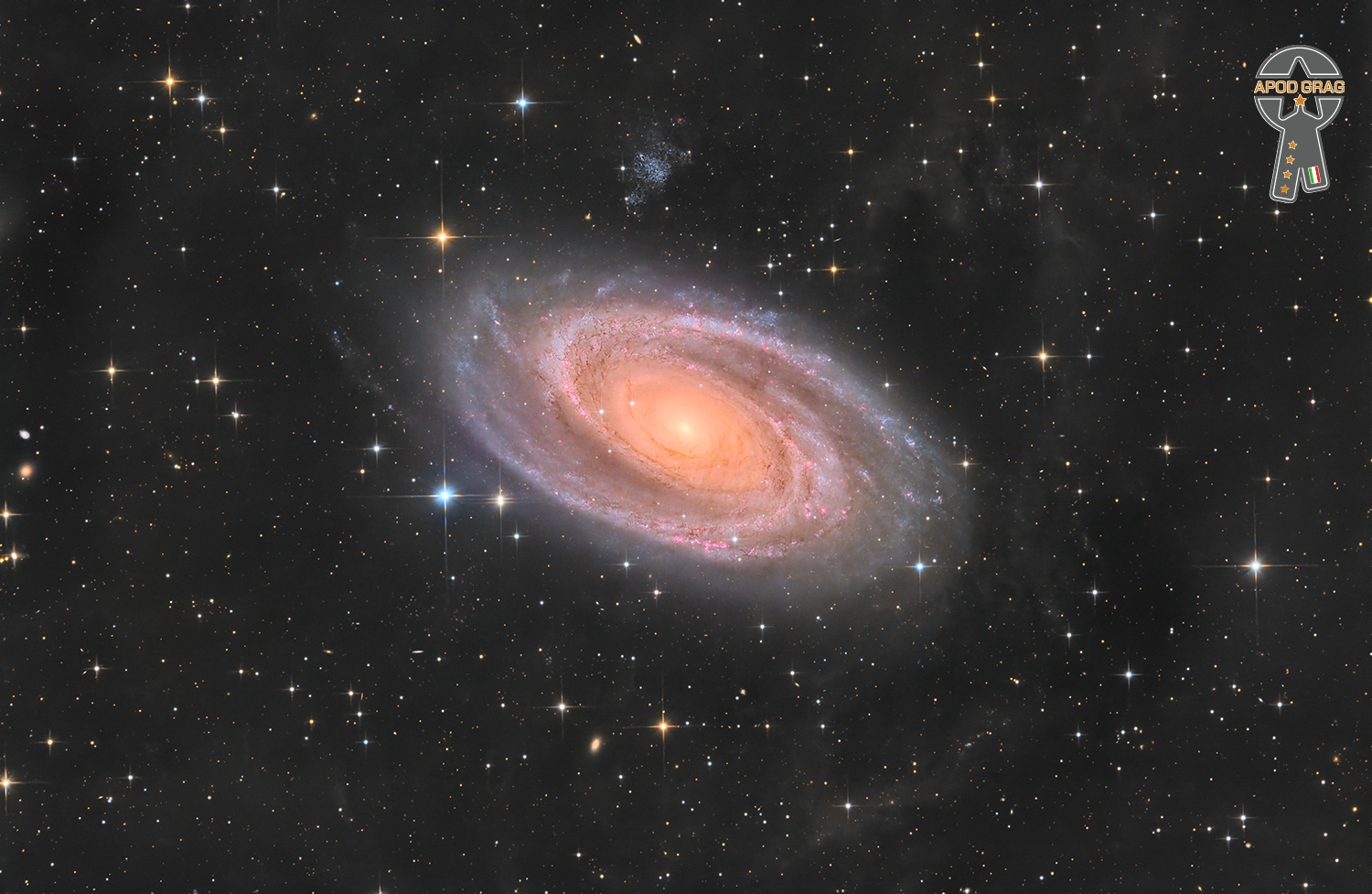Blog
The Rosette Nebula (also known as Caldwell 49) is an H II region located near one end of a giant molecular cloud in the Monoceros region of the Milky Way Galaxy. The open cluster NGC 2244 (Caldwell 50) is closely associated with the nebulosity, the stars of the cluster having been formed from the nebula’s matter.
The nebula has been noted to be having a shape reminiscent of a human skull, and is sometimes referred to as the “Skull Nebula.” It is not to be confused with NGC 246, which is also nicknamed the “Skull Nebula.
- NGC 2237 – Part of the nebulous region (Also used to denote whole nebula)

Lakshminarayana Shankar (born 26 April 1950), better known as L. Shankar, Shankar and Shenkar, is an Indian violinist, singer and composer.
Shankar was born in Madras, India, and raised in Ceylon (current-day Sri Lanka), where his father V. Lakshminarayana, a violinist and singer, worked as a teacher at the Jaffna College of Music. He learned to play the violin and first performed in public in a Ceylonese temple at the age of seven. In 1969, he went to the United States, where he studied ethnomusicology at Wesleyan University. After performing with various Indian singers for several years, Shankar founded a trio with his brothers, L. Vaidyanathan and L. Subramaniam, that performed throughout India.
more...Preston Haynes Love (April 26, 1921 – February 12, 2004) was an American saxophonist, bandleader, and songwriter from Omaha, Nebraska, United States, best known as a sideman for jazz and rhythm and blues artists like Count Basie and Ray Charles.
Preston Love grew up in North Omaha and graduated from North High.
He became renowned as a professional sideman and saxophone balladeer in the heyday of the big band era. He was a member of the bands of Nat Towles, Lloyd Hunter, Snub Mosley, Lucky Millinder and Fats Wallerbefore getting his big break with the Count Basie Orchestra when he was 22. Love played and recorded with the Count Basie band from 1945–1947, and played on Basie’s only No. 1 hit record, “Open The Door Richard.”
more...Theodore Marcus “Teddy” Edwards (April 26, 1924 – April 20, 2003) was an American jazz tenor saxophonist.
Edwards was born in Jackson, Mississippi, United States. He learned to play at a very early age, first on alto saxophone and then clarinet. His uncle sent for him to come to Detroit to live because he felt opportunities were better. Due to illness in the family, he went back to Jackson and ventured to Alexandria, Louisiana. He was persuaded by Ernie Fields to join his band after going to Tampa, Florida. Edwards had planned to go to New York City, but Fields convinced him he could get there by way of Washington, D.C., if he worked with his band.
more...John Ned Shines (April 26, 1915 – April 20, 1992) was an American blues singer and guitarist.
Shines was born in the community of Frayser, in Memphis, Tennessee. He was taught to play the guitar by his mother and spent most of his childhood in Memphis, playing slide guitar at an early age in juke joints and on the street. He moved to Hughes, Arkansas, in 1932 and worked on farms for three years, putting aside his music career. A chance meeting with Robert Johnson, his greatest influence, gave him the inspiration to return to music. In 1935, Shines began traveling with Johnson, touring in the United States and Canada. They parted in 1937, one year before Johnson’s death.
more...M81 is a spiral galaxy with a relatively modest diameter of 60,000 light years. In 1993, the observation of about thirty cepheids by the Hubble telescope made it possible to estimate the distance of the galaxy at 11.8 million light years, making it one of the closest to ours. It is part of the same group of galaxies as M82, the G2 group (list of Vaucouleurs). This group is part of the supercluster of the Virgin, as is our local group.
M81 cannot be seen without an instrument. It is clearly visible with binoculars because of its magnitude of 6.9. In a 114 mm telescope, the nucleus appears as bright and surrounded by a diffuse halo. A 350 mm instrument and good observation conditions are needed to detect the spiral arms of the galaxy.

William P. Homans III, (born 1949) professionally known as “Watermelon Slim”, is an American bluesmusician. He plays both guitar and harmonica. He is currently signed to NorthernBlues Music, based in Toronto, Ontario. Homans has also earned bachelor’s and master’s degrees from University of Oregon and Oklahoma State University.
Homans was born in Boston, Massachusetts, United States, but has said that he was raised in North Carolina, where he was first exposed to blues music from about the time he was five years old. During childhood, he sang in choirs and glee clubs. Homans later explained that he first played music in 1958, on a set of bongo drums. A year later, he acquired a harmonica. It took almost a decade before he became sufficiently experienced to take on a professional gig at Middlebury College in Vermont.
more...Albert Nelson (April 25, 1923 – December 21, 1992), known by his stage name Albert King, was an American guitarist and singer who is often regarded as one of the greatest and most influential bluesguitarists of all time. He is perhaps best known for his popular and influential album Born Under a Bad Sign (1967) and its title track. He, B.B. King, and Freddie King, all unrelated, were known as the “Kings of the Blues”. The left-handed King was known for his “deep, dramatic sound that was widely imitated by both blues and rock guitarists.”
He was once nicknamed “The Velvet Bulldozer” because of his smooth singing and large size–he stood taller than average, with sources reporting 6 ft 4 in (1.93 m) or 6 ft 7 in (2.01 m), and weighed 250 lb (110 kg) – and also because he drove a bulldozer in one of his day jobs early in his career.
King was inducted into the Blues Hall of Fame in 1983. He was posthumously inducted into the Rock and Roll Hall of Fame in 2013. In 2011, he was ranked number 13 on Rolling Stone‘s 100 Greatest Guitarists of All Time.
Albert King was born on a cotton plantation in Indianola, Mississippi. During childhood he sang at a church with a family gospel group, in which his father played the guitar. One of 13 children, he grew up picking cotton on plantations near Forrest City, Arkansas, where the family moved when he was eight years old.
more...Ella Jane Fitzgerald (April 25, 1917 – June 15, 1996) was an American jazz singer, sometimes referred to as the “First Lady of Song”, “Queen of Jazz”, and “Lady Ella”. She was noted for her purity of tone, impeccable diction, phrasing, timing, intonation, and a “horn-like” improvisational ability, particularly in her scat singing.
After a tumultuous adolescence, Fitzgerald found stability in musical success with the Chick Webb Orchestra, performing across the country but most often associated with the Savoy Ballroom in Harlem. Her rendition of the nursery rhyme “A-Tisket, A-Tasket” helped boost both her and Webb to national fame. After taking over the band when Webb died, Fitzgerald left it behind in 1942 to start her solo career. Her manager was Moe Gale, co-founder of the Savoy, until she turned the rest of her career over to Norman Granz, who founded Verve Records to produce new records by Fitzgerald. With Verve she recorded some of her more widely noted works, particularly her interpretations of the Great American Songbook.
While Fitzgerald appeared in films and as a guest on popular television shows in the second half of the twentieth century, her musical collaborations with Louis Armstrong, Duke Ellington, and The Ink Spots were some of her most notable acts outside her solo career. These partnerships produced some of her best-known songs such as “Dream a Little Dream of Me“, “Cheek to Cheek“, “Into Each Life Some Rain Must Fall“, and “It Don’t Mean a Thing (If It Ain’t Got That Swing)“. In 1993, after a career of nearly sixty years, she gave her last public performance. Three years later, she died at age 79 after years of declining health. Her accoladesincluded 14 Grammy Awards, the National Medal of Arts, the NAACP‘s inaugural President’s Award, and the Presidential Medal of Freedom.
Fitzgerald was born on April 25, 1917, in Newport News, Virginia. She was the daughter of William Fitzgerald and Temperance “Tempie” Henry, both described as “mulatto” in the 1920 census. Her parents were unmarried but lived together in the East End section of Newport News for at least two and a half years after she was born. In the early 1920s, Fitzgerald’s mother and her new partner, a Portuguese immigrant named Joseph da Silva, moved to Yonkers, in Westchester County, New York.
more...A menagerie of interesting astronomical finds fill this image from the NASA/ESA Hubble Space Telescope. As well as several large elliptical galaxies, a ring-shaped galaxy is lurking on the right of this image. A pair of bright stars are also visible at the left of this image, notable for their colourful criss-crossing diffraction spikes. This collection of astronomical curiosities is the galaxy cluster ACO S520 in the constellation Pictor, which was captured by Hubble’s Advanced Camera for Surveys. This is one of a series of Hubble observations searching for massive, luminous galaxy clusters that had not been captured by earlier surveys. Appropriately, the proposal for observing time was named “They almost got away”! Astronomers took advantage of occasional gaps in Hubble’s busy schedule to capture images of these barely-explored galaxy clusters, revealing a wealth of interesting targets for further study with Hubble and the NASA/ESA/CSA James Webb Space Telescope. Galaxy clusters are among the largest known objects in the Universe, and studying these objects can provide insights into the distribution of dark matter, which is responsible for most of the mass of a galaxy cluster. The vast masses of galaxy clusters is what causes many of them to act as gravitational lenses which distort and magnify light from even more distant objects. This can allow astronomers to use galaxy clusters as a kind of natural gravitational telescope to reveal distant objects that would usually be too faint to resolve — even for the crystal-clear vision of Hubble. [Image description: A collection of oval-shaped, elliptical galaxies. The largest has two neighbouring bright spots in the core. It and two others look like galaxy clusters, with surrounding smaller galaxies. On the left edge of the image are two bright stars with four long spikes, and on the right edge is a small ring-shaped galaxy. Smaller stars and galaxies are spread evenly across the dark background.]

John Christopher Williams AO OBE (born 24 April 1941) is an Australian virtuosic classical guitarist renowned for his ensemble playing as well as his interpretation and promotion of the modern classical guitar repertoire. In 1973, he shared a Grammy Award in the Best Chamber Music Performance category with fellow guitarist Julian Bream for Together (released in the US as Julian and John (Works by Lawes, Carulli, Albéniz, Granados)). Guitar historian Graham Wade has said that “John is perhaps the most technically accomplished guitarist the world has seen.
more...Joe Henderson (April 24, 1937 – June 30, 2001) was an American jazz tenor saxophonist. In a career spanning more than four decades, Henderson played with many of the leading American players of his day and recorded for several prominent labels, including Blue Note, Milestone, and Verve.
Born in Lima, Ohio, United States, Henderson was one of fourteen children. He was encouraged by his parents Dennis and Irene (née Farley) and older brother James T. to study music. He dedicated his first album to them “for being so understanding and tolerant” during his formative years. Early musical interests included drums, piano, saxophone and composition. According to Kenny Dorham, two local piano teachers who went to school with Henderson’s brothers and sisters, Richard Patterson and Don Hurless, gave him a knowledge of the piano. He was particularly enamored of his brother’s record collection. It seems that a hometown drummer, John Jarette, advised Henderson to listen to musicians like Lester Young, Stan Getz, Dexter Gordon and Charlie Parker. He also liked Flip Phillips, Lee Konitz and the Jazz at the Philharmonic recordings. However, Parker became his greatest inspiration. His first approach to the saxophone was under the tutelage of Herbert Murphy in high school. In this period of time, he wrote several scores for the school band.
more...John Arnold Griffin III (April 24, 1928 – July 25, 2008) was an American jazz tenor saxophonist. Nicknamed “the Little Giant” for his short stature and forceful playing, Griffin’s career began in the mid-1940s and continued until the month of his death. A pioneering figure in hard bop, Griffin recorded prolifically as a bandleader in addition to stints with pianist Thelonious Monk, drummer Art Blakey, in partnership with fellow tenor Eddie “Lockjaw” Davis and as a member of the Kenny Clarke/Francy Boland Big Band after he moved to Europe in the 1960s. In 1995, Griffin was awarded an Honorary Doctorate of Music from Berklee College of Music.
Griffin studied music at DuSable High School in Chicago under Walter Dyett, starting out on clarinet before moving on to oboe and then alto saxophone. While still at high school at the age of 15, Griffin was playing with T-Bone Walker in a band led by Walker’s brother.
more...More Posts
- David Honeyboy Edwards Day
- World Music with Malagueño Juan Moreno
- Daily Roots with Paulette Wright
- The Cosmos with Arp 87
- Sam Tshabalala Day
- R D Burman Day
- George Braith Day
- Elmo Hope Day
- World Music with Samaia Sukhishvilebi
- Daily Roots with Paulette Pearce
- The Cosmos with Serpens South
- Nicole Saba Day
- Reggie Workman Day
- Big Bill Broonzy Day
- World Music with Seckou Keita
- Daily Roots with Sonia Spence
- The Cosmos with Sh2-71
- Carly Simon Day
- Joe Chambers Day
- Johnny Smith Day